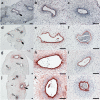Flow-through isolation of human first trimester umbilical cord endothelial cells
- PMID: 34169358
- PMCID: PMC8550006
- DOI: 10.1007/s00418-021-02007-7
Flow-through isolation of human first trimester umbilical cord endothelial cells
Abstract
Human umbilical vein and artery endothelial cells (HUVEC; HUAEC), placental endothelial cells (fpAEC), and endothelial colony-forming cells (ECFC) from cord blood are a widely used model for researching placental vascular development, fetal and placental endothelial function, and the effect of adverse conditions in pregnancy thereon. However, placental vascular development and angiogenesis start in the first weeks of gestation, and adverse conditions in pregnancy may also affect endothelial function before term, suggesting that endothelial cells from early pregnancy may respond differently. Thus, we established a novel, gentle flow-through method to isolate pure human umbilical endothelial cells from first trimester (FTUEC). FTUEC were characterized and their phenotype was compared to the umbilical endothelium in situ as well as to other fetal endothelial cell models from term of gestation, i.e. HUVEC, fpAEC, ECFC. FTUEC possess a CD34-positive, juvenile endothelial phenotype, and can be expanded and passaged. We regard FTUEC as a valuable tool to study developmental processes as well as the effect of adverse insults in pregnancy in vitro.
Keywords: Endothelial cells; First trimester; HUAEC; HUVEC; Human placenta; Isolation; Umbilical cord.
© 2021. The Author(s).
Conflict of interest statement
The authors declare no competing interests.
Figures






References
-
- Blaschitz A, Gauster M, Fuchs D, Lang I, Maschke P, Ulrich D, Karpf E, Takikawa O, Schimek MG, Dohr G, Sedlmayr P. Vascular endothelial expression of indoleamine 2,3-dioxygenase 1 forms a positive gradient towards the feto-maternal interface. PLoS ONE. 2011;6(7):e21774. doi: 10.1371/journal.pone.0021774. - DOI - PMC - PubMed
-
- Charolidi N, Host AJ, Ashton S, Tryfonos Z, Leslie K, Thilaganathan B, Cartwright JE, Whitley GS. First trimester placental endothelial cells from pregnancies with abnormal uterine artery Doppler are more sensitive to apoptotic stimuli. Lab Invest. 2019;99(3):411–420. doi: 10.1038/s41374-018-0139-z. - DOI - PMC - PubMed
-
- Cvitic S, Novakovic B, Gordon L, Ulz CM, Muhlberger M, Diaz-Perez FI, Joo JE, Svendova V, Schimek MG, Trajanoski S, Saffery R, Desoye G, Hiden U. Human fetoplacental arterial and venous endothelial cells are differentially programmed by gestational diabetes mellitus, resulting in cell-specific barrier function changes. Diabetologia. 2018;61(11):2398–2411. doi: 10.1007/s00125-018-4699-7. - DOI - PMC - PubMed
MeSH terms
Grants and funding
LinkOut - more resources
Full Text Sources

